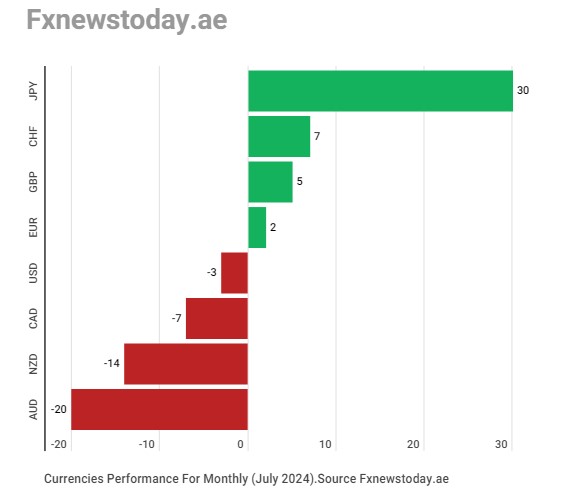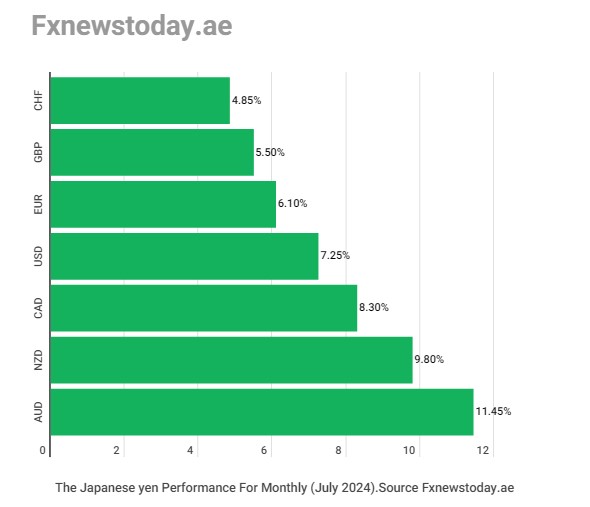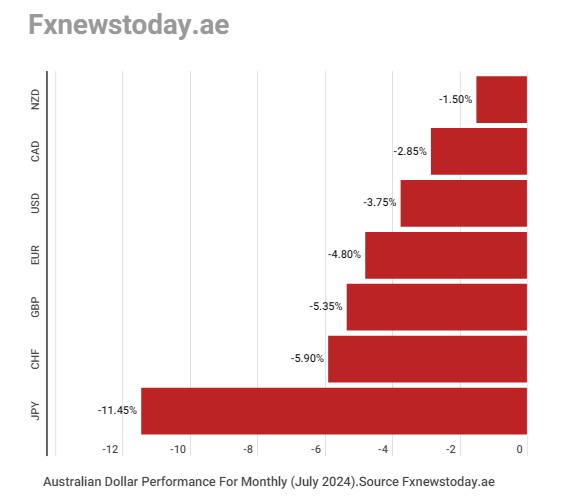Sterling falls to four-week trough after UK rate cut
- BOE cuts interest rates for first time since 2020
- Concerns renewed about UK-US rate gap
The pound fell in European trade on Friday against the dollar for the second straight session, plumbing four-week lows and about to mark the third weekly profit in a row as the Bank of England started its policy easing cycle with an interest rate cut this week.
The decision rekindled concerns about the widening UK-US interest rate gap in favor of the US.
The Price
The GBP/USD fell 0.3% today to $1.2707, the lowest since July 3, with a session-high at $1.2751.
The pound closed down 0.9% on Thursday against the dollar, marking the heftiest such loss since April 10 following the Bank of England’s policy meeting.
Weekly Trades
The pound is down 1.25% so far this week against the US dollar, on track for the third weekly loss in a row, and the largest since early April, amid concerns about the increasing UK-US rate gap.
The BOE
As expected, the Bank of England cut interest rates by 25 basis points to 5%, the first such cut since March 2020.
The BOE believes it can execute more interest rate cuts without flaring inflation, with several policymakers still holding a position of maintaining rates unchanged at the last vote.
Bailey
Bank of England Governor Andrew Bailey said the decision to cut interest rates was balanced, and he expects inflation to edge up once again before slowing down towards the bank’s targets.
Bailey believes the main goal would be reaching the 2% inflation target by mid-2025.
Rate Gap
Following the BOE’s decisions, the US-UK interest rate gap widened to 50 basis points in favor of the US, the largest such gap since May 2023.
Yen about to mark biggest weekly profit since April after BOJ decisions
- Yen gives up five-month high on profit-taking
- BOJ raises interest rates to 2008 highs
- BOJ announces aggressive policy tightening plans
- More aggressive remarks by BOJ Governor Ueda
- US yields tumble to six-month lows
Yen fell in Asian trade on Friday for the first time in four days against a basket of major rivals, moving off five-month highs against the dollar on profit-taking.
Despite the decline, the yen is still on track for the fifth weekly profit in a row, and the largest since late April following the Bank of Japan’s aggressive policy meeting this week.
The BOJ raised interest rates for the second time this year to 2008 highs and announced policy tightening plans, including cuts to government bonds purchases by half across two years, with governor Kazuo Ueda saying there’s no specific ceiling for interest rates in the current normalizing cycle.
On the other hand, the Fed opened the door for US interest rate cuts in September, which would reduce the Japan-US interest rate gap further and boost investments in the yen and trigger further unwinding of the carry trades.
As US 10-year treasury yields plumb six-month lows, the yields gap with Japan is shrinking and making Japanese bonds a bit more attractive to investors, in turn boosting the yen.
The Price
The USD/JPY rose 0.3% to 149.78, with a session-low at 148.86.
The yen rose 0.4% on Thursday against the dollar, the third profit in a row, marking five-month highs at 148.51.
Weekly Trades
The yen is up 2.6% so far this week against the dollar on track for the fifth weekly profit in a row and the largest since April.
The BOJ
The Bank of Japan raised interest rates by 15 basis points yesterday to 0.25%, the highest since 2008, while analysts expected no changes.
It’s the second Japanese rate hike this year, after the BOJ’s similar decision at the March meeting by exiting negative rates for the first time since 2007.
The internal vote was 7-2 in favor of the rate hike, showing increasing confidence by policymakers and the pressure of accelerating wages and prices.
The BOJ announced a major two-year policy tightening plan, that includes cutting government bonds purchases by 400 billion yen every quarter until it reaches the point of purchasing 3 trillion yen a month in the first quarter of 2026, compared to 6 trillion yen a month currently.
Ueda
BOJ Governor Kazuo Ueda said the bank will continue to raise interest rates and adjust the pace of policy easing according to economic developments.
Ueda said that prices face upward risks, and personal consumption remains strong despite latest inflation data, while growing wages and income will provide further support for spending.
Ueda doesn’t expect rate hikes to have a negative impact on the economy, and he doesn’t take into consideration an upward ceiling at 0.5% for interest rates.
The Fed
Federal Reserve Chair Jerome Powell said on Wednesday that if inflation trended downwards in line with expectations and growth remained strong, a rate cut is on the table at the September meeting.
US Rates
Before this week’s Fed meeting, markets were expecting rate cuts totaling 50 basis points this year, but now they raised their estimates of 75 basis points.
Rate Gap
Investors sold the yen mercilessly due to the massive rate gap between Japan and the US, with many traders conducting “carry trade” operations, through which they borrow the yen and buy higher yield currencies such as the dollar.
However, as the Japan-US rate gap shrank this week to 525 basis points and could shrink as far as 475 basis points this year, the yen is gathering huge support and the carry trades are unwinding quickly.
US Yields
US 10-year treasury yields fell 0.9% on Friday on track for the seventh decline in a row, hitting six-month lows at 3.943%, in turn hurting the dollar’s standing.
In July 2024, why did the Japanese yen outperform all other currencies?
• Bank of Japan intervenes in the foreign exchange market to support the local currency
- Accelerated unwinding of carry yen trades due to Japanese interest rate speculation
- Rising inflationary pressures on the Japanese Central Bank
- Bank of Japan raises interest rates to the highest level since 2008
- Bank of Japan announces an aggressive quantitative tightening plan
- More aggressive comments from Bank of Japan Governor "Kazuo Ueda"
- Increased likelihood of US interest rate cuts being fully priced in
The foreign exchange market ended its July 2024 trading session with the final settlement of prices on Wednesday, July 31. Throughout the month, the Japanese currency demonstrated an impressive performance, dominating the list of major currencies. This was due to the Bank of Japan's intervention to support the local currency against excessive weakness, as well as the accelerated unwinding of carry yen trades due to increasing speculation about additional Japanese interest rate hikes.
With rising inflationary pressures on policymakers at the Japanese Central Bank, the likelihood of a second interest rate hike this year increased, which indeed happened as the Bank of Japan raised the interest rate to its highest level since 2008.
The Bank of Japan also announced an aggressive quantitative tightening plan, gradually reducing government bond purchases over two years, aiming to halve them by the first quarter of 2026. Governor "Kazuo Ueda" stated that there is no specific cap for the benchmark interest rate during the current normalization cycle.
The Federal Reserve also strongly opened the door for US interest rate cuts in September, which would further narrow the interest rate gap between Japan and the United States, enhancing investment opportunities in the Japanese yen and accelerating the unwinding of carry yen trades.
Returning to the list of winning currencies in July, the Australian dollar came last, due to risk aversion in global markets and concerns related to the Chinese economy, Australia's largest trading partner.
Before detailing the factors that supported the Japanese yen and heavily pressured the Australian dollar, let's first review the performance of the eight major currencies in the foreign exchange market during July 2024.

The Japanese yen rose by 30 points on the "FX News Today" monthly index for measuring currency strength, followed by the Swiss franc in second place with 7 points, and the British pound in third place with 5 points. The Australian dollar ranked last with a negative 20 points.
Japanese Yen

Looking at the detailed performance of the Japanese yen in July against the seven major currencies, it swept the Australian dollar with a gain of 11.45%, the largest monthly gain since May 2010, reaching a four-month high of 99.21 yen on Thursday, July 25.
It rose by 9.8% against the New Zealand dollar, the largest monthly gain since May 2012, reaching a six-month high of 89.80 yen on Thursday, July 15.
It climbed by 8.3% against the Canadian dollar, achieving the largest monthly gain since January 2015, reaching a six-month high of 108.33 yen on Thursday, July 25.
It increased by 7.25% against the US dollar, the largest monthly gain since November 2022, reaching a four-month high of 151.94 yen on Thursday, July 25.
It rose by 6.1% against the euro, the largest monthly gain since June 2016, reaching a four-month high of 162.01 yen on Thursday, July 25.
It added 5.5% against the British pound, the largest monthly gain since May 2019, reaching a two-month high of 192.16 yen on Thursday, July 25.
It climbed by 4.85% against the Swiss franc, the largest monthly gain since June 2016, reaching a two-month high of 170.31 yen on Thursday, July 25.
Bank of Japan Intervention
Recent daily transaction data from the Japanese Central Bank showed that the Bank of Japan spent nearly 6 trillion yen "35 billion US dollars" on Thursday and Friday, July 11-12, less than three months after the last intervention in the foreign exchange market.
The Bank of Japan intervened at the end of April and early May, spending nearly 9.8 trillion yen (61.55 billion dollars) to support the currency. There will be a report at the end of the month from the Ministry of Finance that will confirm the amount spent on the new intervention.
What is Carry Trade?
Carry trade is one of the best and most important strategies relied upon by many experts and traders in the world of trading. It is a way to build long-term trading positions to benefit from the interest rate differences between currencies in the forex market.
Carry trades in the forex market are executed by a trader selling a low-yield currency and buying a high-yield currency while financing the trading position daily, weekly, or over any period chosen by the trader, allowing them to benefit from the interest rate differential.
The low-yield currency is called the "funding currency," and the high-yield currency is called the "yield currency." In the USD/JPY pair, the yield currency is the US dollar, and the funding currency is the Japanese yen.
The trader borrows the low-yield yen through forward points daily, weekly, or over any other period and then lends the high-yield US dollar through forward points.
If we assume that the yields on the low-yield currency continue to fall or the yields on the high-yield currency continue to rise, financing this trade daily is an easy way to make profits.
Unwinding Carry Trade Positions
Currently, long-term carry trade positions on the Japanese currency are accelerating due to strong speculation regarding the upcoming Bank of Japan monetary policy meeting scheduled for late July.
Sources told Reuters that the Bank of Japan is likely to discuss whether to raise interest rates and unveil a plan to cut bond purchases by nearly half in the coming years, indicating its intention to steadily retreat from its massive monetary stimulus.
In contrast, weak economic data in the United States raised the likelihood of the Federal Reserve cutting US interest rates by 25 basis points in September from 94% to 100% and in November from 98% to 100%.
Thus, the Bank of Japan is taking new steps toward normalizing monetary policy for the world's third-largest economy, while the Federal Reserve is approaching easing monetary policy and beginning a cycle of US interest rate cuts.
Inflation in Tokyo
Government data showed that core inflation in Tokyo rose by 2.2% annually in July, from 2.1% in the previous month, matching market expectations of a 2.2% increase.
Prices in Japan are currently accelerating above the Bank of Japan's inflation target of 2.0%, increasing the likelihood of additional Japanese interest rate hikes this year.
Bank of Japan
On Wednesday, July 31, 2024, the Bank of Japan raised the benchmark interest rate by about 15 basis points to 0.25%, the highest level since 2008 during the global financial crisis, contrary to market expectations of keeping Japanese interest rates unchanged at 0.10%.
The new interest rate hike is the second this year, following the Bank of Japan's decision in March to exit the negative interest rate policy, raising the short-term interest rate by 20 basis points to 0.10%, the first Japanese interest rate increase since 2007.
The Bank of Japan stated that it would continue to raise the benchmark interest rate and adjust the degree of monetary easing, assuming its economic outlook is met.
The Bank of Japan also announced a quantitative tightening plan over two years, gradually reducing government bond purchases by about 400 billion yen per quarter, reaching around 3 trillion yen "20 billion dollars" monthly in the first quarter of 2026. The bank currently conducts government bond purchases of about 6 trillion yen monthly.
Kazuo Ueda
Bank of Japan Governor "Kazuo Ueda" said: We will continue to raise interest rates in the country while adjusting the pace of monetary easing if our current economic forecasts are met.
Ueda added: There are upside risks to price levels. Personal consumption remains strong despite the clear effects of inflation. Rising wages and income levels will provide additional support for personal consumption. Wage growth momentum has increased broadly, both among small and medium-sized companies. Import prices are rising again, warranting further attention.
Ueda clarified: I do not see that raising interest rates will have significant negative effects on the Japanese economy, and the Bank of Japan does not consider a cap on interest rates at 0.5%.
Federal Reserve
Federal Reserve Chairman "Jerome Powell" said on Wednesday, July 31: If we see inflation moving downward... somewhat in line with expectations, and growth remains reasonably strong, and the labor market remains consistent with current conditions, I think a rate cut may be on the table at the September meeting.
US Interest Rates
Global financial markets have long anticipated a 25 basis point cut in US interest rates in September, but after this week's Federal Reserve meeting, traders became more confident in this cut, expecting cuts of around 75 basis points this year.
Interest Rate Gap
Investors have relentlessly sold the yen for months, given Japan's low interest rates compared to anywhere else, especially the United States, leading to the accumulation of bearish positions on the Japanese currency that some have been forced to unwind.
The interest rate gap between the United States and Japan has created a highly profitable trading opportunity, as traders borrow the yen at low rates to invest in dollar-denominated assets for higher returns, known as carry trades.
After the recent decisions by the Bank of Japan and the Federal Reserve, the interest rate gap between Japan and the United States narrowed to 525 basis points in favor of US interest rates, the smallest gap since July 2023. It is expected to narrow to 475 basis points if the US central bank indeed cuts rates by around 75 basis points this year while keeping Japanese rates unchanged.
Australian Dollar

The image above shows the negative performance of the Australian dollar in July 2024 against the seven major currencies in the foreign exchange market due to risk aversion and concerns about the Chinese economy.
Risk Aversion
The massive rise in the Japanese yen levels has indeed turned markets upside down, triggering a broad wave of selling in most global stock markets, led by technology stocks, as well as a decline in precious metals, led by gold, and cryptocurrencies, led by Bitcoin.
Investors are reevaluating their leveraged bets, changing their investment strategies, and trying to mitigate increasing risks in the volatile market environment.
Chinese Economy
Sudden interest rate cuts in China have raised concerns that Chinese authorities are struggling to revive the world's second-largest economy. The People's Bank of China implemented a surprise interest rate cut on Monday, July 22, followed by a cut in the lending rate on its medium-term lending facilities on Thursday, July 25.
Gold continues to break records even as dollar gains ground
Gold prices rose on Thursday to a new record high even as the dollar rose against most major rivals.
Yesterday, the Federal Reserve decided to maintain interest rates unchanged at below 5.5%, but said that inflation control is progressing as planned.
Fed Chair Jerome Powell said it might be appropriate to cut interest rates at the September meeting as policymakers assess new data.
Earlier US data showed the manufacturing PMI down to 46.8 in July from 48.5 in June.
US unemployment claims rose to 249 thousand last week, while analysts expected a smaller increase to 236 thousand.
Otherwise, the dollar index rose 0.3% as of 21:26 GMT to 104.4, with a session-high at 104.4, and a low at 103.8.
On trading, gold spot prices rose 0.5% as of 21:28 GMT to $2486 an ounce.




